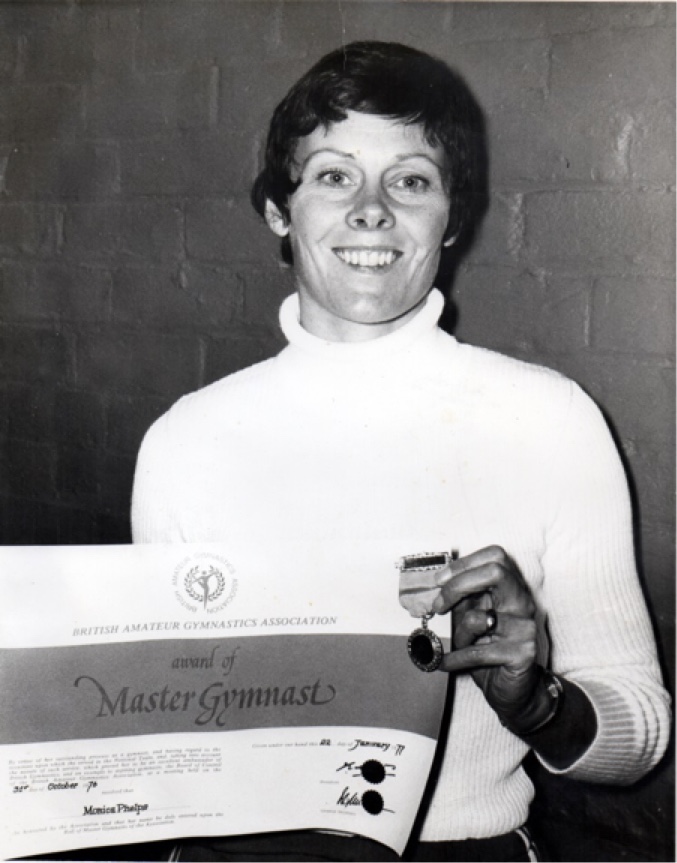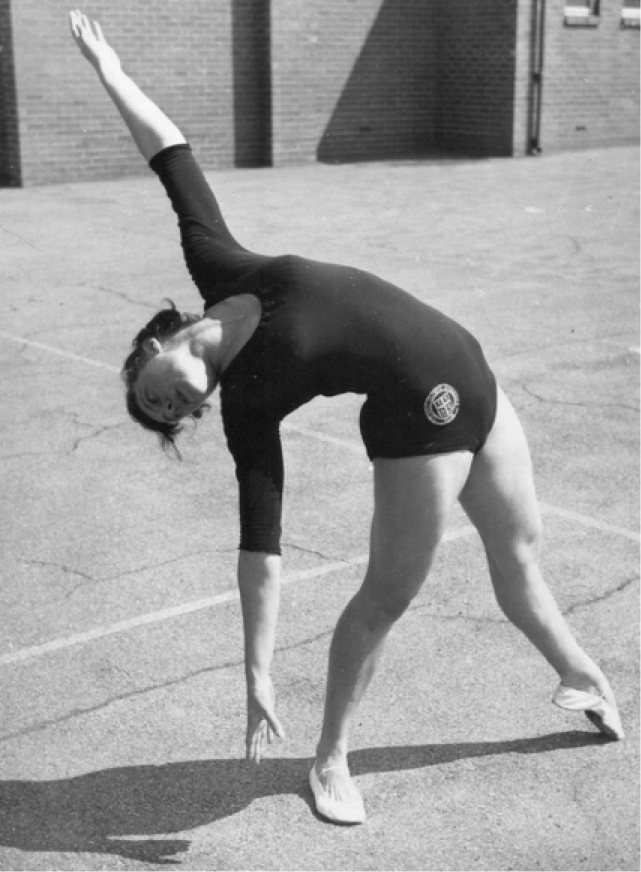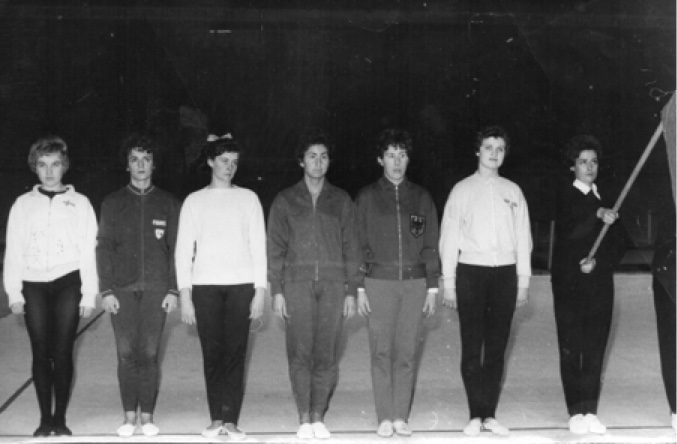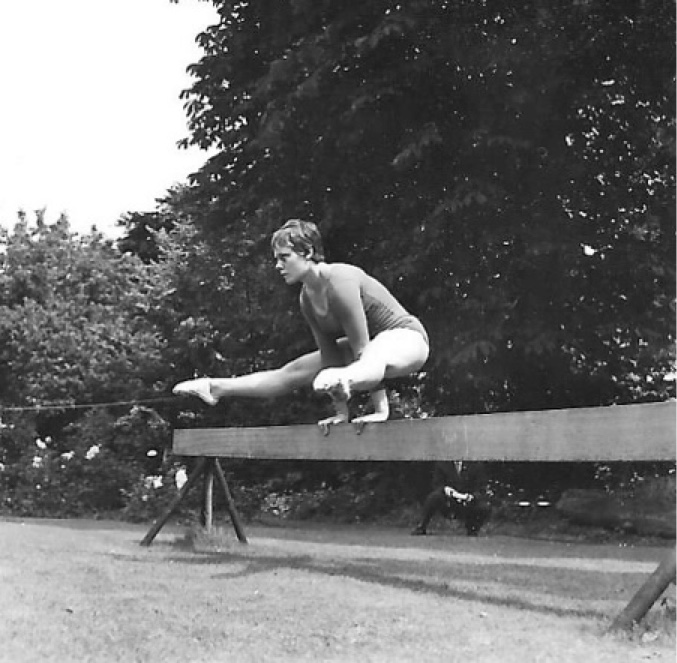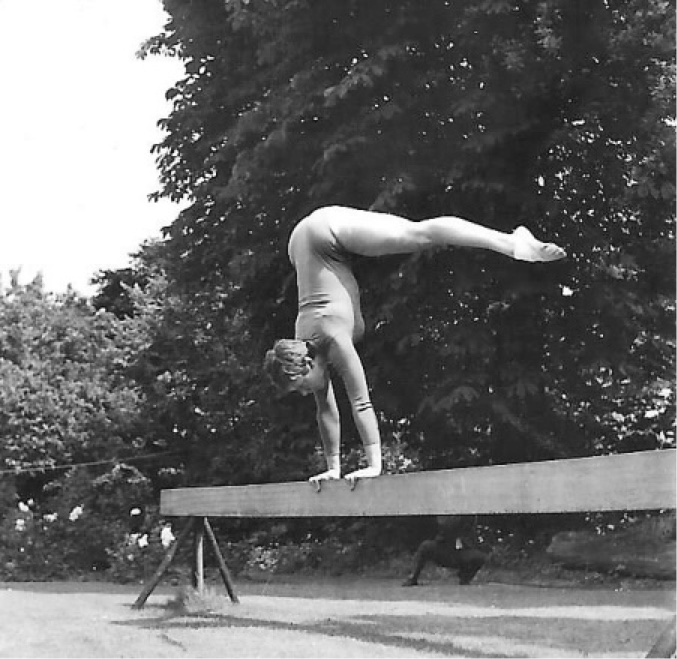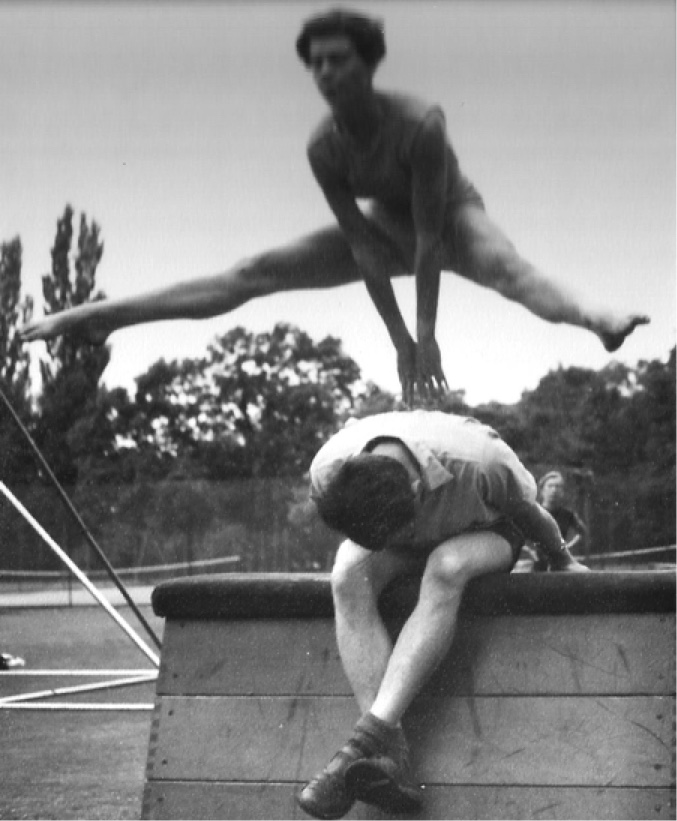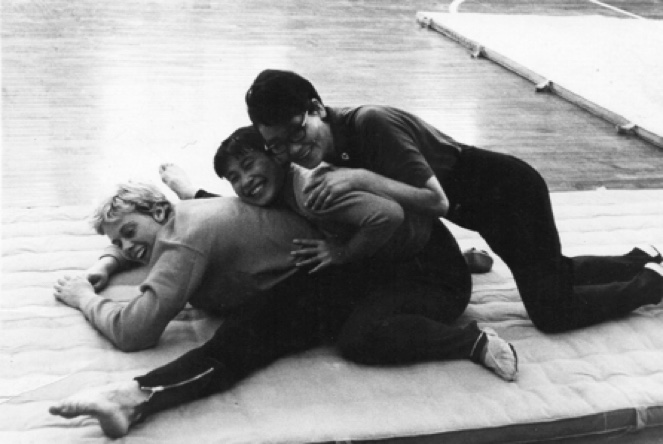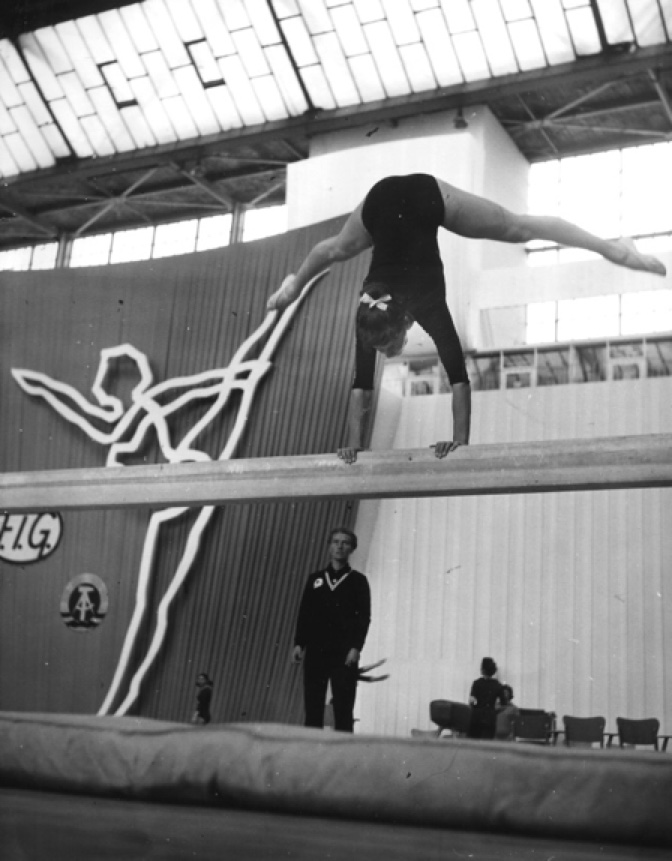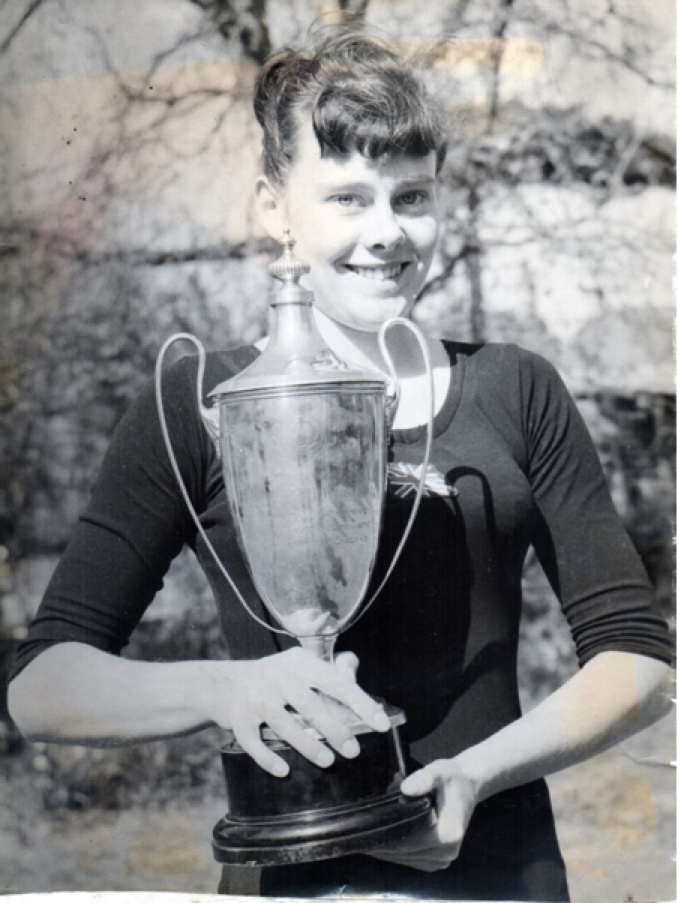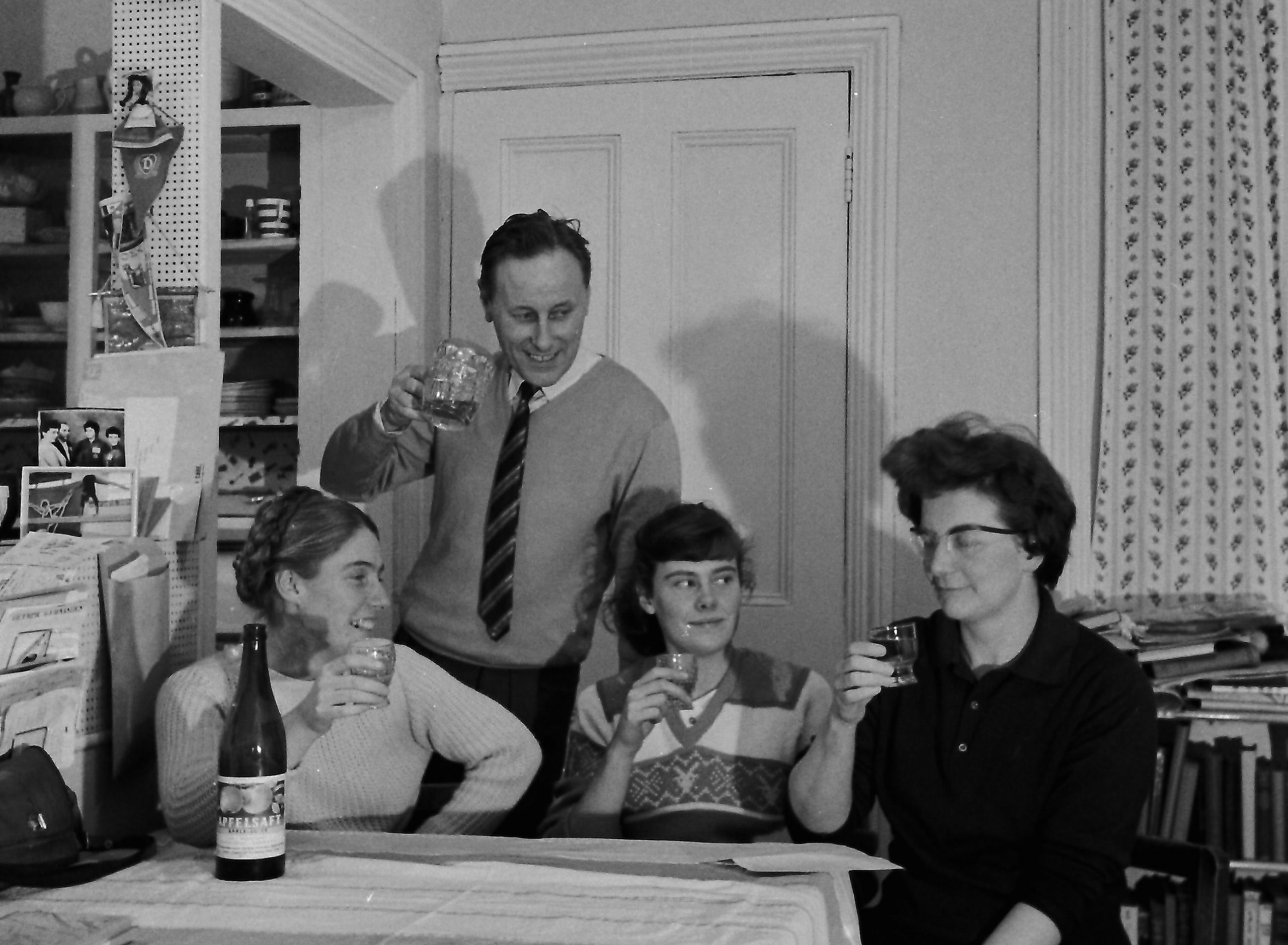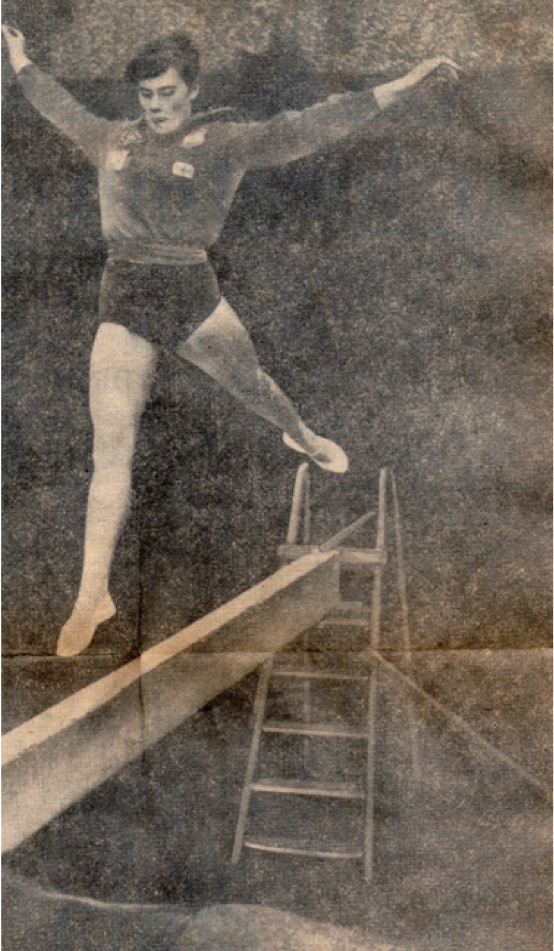MONICA PHELPS
(NEE RUTHERFORD)
by herself
I began participating in gymnastics by chance. My P.E. teacher started an
As the youngest of five, I remember being adored by my much older siblings, two brothers and two sisters. In 1953 prior to my starting Fulwell Secondary Modern, my Mum had been very ill, she had a mastectomy and was fragile for a couple of years, so our family had been through a very stressful period. They were keen for me to use my excess energy.
Early gymnastics
I do remember that I very quickly fell in love with gymnastics….. Floor and Vault
Each lunch-time I ran home at noon, gobbled down my lunch then ran the half mile back to school for gym practice. I never missed a practice and was always first in the queue at the gym door. Well, I say ‘the gym door’, it was actually the assembly hall, which doubled as a dining hall and was also used for PE. It had a solid, block wood floor, one side was skirted by classrooms. The other wall had radiators and windows which over-looked the playground. At one end was a stage, and each end had a corridor leading to the cloakrooms.
Our vault run was one corridor and the vaulting box/ horse was placed in the opening of the opposite corridor, the hall was a mere 30′ x 30′! After a few months my teacher, Miss Allison (who became Mrs Groom and my Coach and mentor), asked if I would like to enter a competition in Warrington, I didn’t know where that was! I was required to perform two vaults on the full height box, and two agility routines with five linked skills. Apparently, I was quite good because Mr Byers & Miss Bagley whose clubs I visited often told me that I was……. ‘a clever girl’.
The competition was called The British Junior Vault and Agility Championships, which really meant very little to me. I had never travelled outside of County Durham and was like most 13yr old post-war children from the North, rather parochial and naïve.
Early success
Mr Byers, a gymnastics coach from Jarrow took us to the competition. We performed on Recticel matting, which was wide and comfortable in comparison to Fulwell School mats! I don’t recall much detail about the day, other than being asked to demonstrate my routines to lots of people. I did a forward roll to straddle, lift to handstand forward roll, 1 leg exit to cartwheel, round off backward roll piked. In the second routine I began with a handspring dive roll, but don’t recall the other three skills. I was happy to win the Junior Floor, Vault and the combined British Championship in these disciplines but certainly did not foresee that this would be a major stepping stone to such an exciting future. The local papers reported me as a British Champion which brought kudos to my hometown school and club.
I was in my second year at secondary school at that time and became obsessed with gymnastics. My classroom boarded the assembly hall, where Miss Allison taught the gym classes. Most of the upper dividing wall was made up of obscure glass panes, except for one single pane near my desk. I was ”second top’ of the class in year two and we sat in our ranking order, from the back right-hand side of the class, so I was ideally situated for a perfect view into the assembly hall. Ultimately, I was moved into the front row so that I could fully concentrate on my lessons, instead of watching the gym classes!
It’s fair to say, that June and I grew into gymnastics together. Fulwell Gymnastics Club blossomed from a little after school gym club to a national treasure. I was one of a talented group of gymnasts, who practised in a school hall. June took us to a ‘proper gymnasium’, to play on ropes and wall bars and to Jarrow Community Centre wherein a former church hall Mr Byers coached men’s artistic gymnastics (MAG). One of his gymnasts was Jimmy Wilson, who later joined the Army Physical Training Corps becoming a founder member of Fox Gym at Aldershot and ultimately a member of the Great Britain MAG team in the late fifties and early sixties.
The detail, accuracy and chronology of the following years are vague, but I can form the general picture of events from those early days. Doors to opportunities were opened by people we met on our journey, such as Billy Byers, Jimmy Wilson, Mr Colbec from the C.C.P.R. (Central Council for Physical Recreation) and Miss Peters, the P.E organiser for Sunderland Education Authority. Each experience made our journey more enthralling.
Life changing camp at Bisham Abbey
Our club participated in the Festival of Movement and Dance at the Wembley Arena……..a huge event for a group of parochial school girls; none of us had ever been to London. June took us to Cambridge for a week, we stayed in Youth Hostels, went punting on the River Cam and visited Kings College Cambridge. She arranged for me to meet my fourteen-year-old cousin Christopher Catterick who sang in the Kings College Choir and was a recipient of the Maunday Money from the Queen. June provided our little team of gymnasts with an education far beyond the aspirations of our parents. We lived in the days of post-war rationing and money was scarce; families could not afford holidays, but our parents were delighted to subsidise our involvement in these activities.
On reflection, our week’s stay at a Bisham Abbey gymnastics summer camp in 1958 was my life-changing experience. I think June had taken a group of us to a Coaching Course leading to an examination and we were the students. I was overwhelmed by the beauty of Abbey and its situation. The weather was amazing. We slept in dormitories, had midnight feasts and told ghost stories about Lady Hoby who was supposed to haunt the Abbey! I met wonderful people. I met fellow gymnasts and coaches from all over the country. These were people I grew to love and respect, they were like big sisters or aunts and uncles. We all felt loved by them and safe in their company, I grew to respect them……forever.
Jim and Pauline Prestidge came into my life. I met Pat Hurst, multiple British Champion, who was so kind and helpful. She could do the splits on beam, she was skilful on swinging rings and I was so impressed. What I was unaware of at the time but appreciated much later in life, was that these people were also impressed by my talent. Whilst I can accept that I had some, I was not the most talented amongst my peers, but definitely the most dedicated. Thankfully the Bisham Abbey summer camp was held annually and it was the base for national training prior to Lilleshall, so I enjoyed many more visits.
When we returned home after that first camp, our eyes had been opened. June wanted to coach Olympic Gymnastics as it was referred to back then; Educational Gymnastics was taught in schools and the divide between the two was significant! For years the Educationalists retarded the growth of gymnastics, calling it ‘formal’ because skill acquisition had a structure. They considered that it limited creativity, but to me, Educational Gymnastics was akin to attempting to write a story before learning the alphabet! When I had my practical assessment on my final teaching practice, I manipulated my lesson to a more skill oriented lesson
Innovative training
The process to develop the level of gymnastics in our club began in earnest. Firstly my Dad took a large ceiling joist from an old building and installed it in our back garden. One end was fixed to the top of a step ladder and the other end was slotted into the top of our air raid shelter. He painted it in some leftover blue paint, acquired some matting to cover the grass and I was delighted! That’s where I practised towards my first British Championship. By now we had acquired the compulsory exercises for the British Championships. To train on the bars we travelled to Jarrow and used the men’s P. bars which were adjustable, but I had to learn a short arm overswing from the top bar. June had a makeshift set of bars made from scaffold poles and old bar rails installed in her garden. The garden shed loomed rather close to my landing point so we banked the primitive coconut matting over a flower bed at the shed base. This is where I learned the dismount for the 1959 British Championships, which were held in a school hall, on a block wood floor in Cardiff. Gwynned Lingard won the ladies title. There was also quite a contingent of Welsh gymnasts: Margaret Neale, Dorothy Summers, Mary McCarthy and my great friend and rival Denise Goddard.
There was a costly deduction of one whole mark for using a mat on the floor for somersault landings, in our day tuck backs, straight backs and straight back half twist were the maximum difficulty. Frankly, I’m very pleased that we reached that
During 1960 we managed to get some asymmetric bar bases made by a local shipyard, Austin and Pickersgill and we purchased the hickory bar rails complete with steel core. My father was a member of the Fulwell Parents Association which raised funds for apparatus purchase. They bought a beam and had a copy made and a springboard which my Dad replicated. When we went to the Gymnastraeda in Germany in 1961 we returned with a Reuther board in our mini-bus.
During 1960 we began to train more seriously, but I had G.C.E.’s to contend with which we successfully negotiated. The 1961 British Championships included compulsory and voluntary exercises, and there was a qualifying competition for the final which was to be staged at the Albert Hall. It was sponsored by the Daily Herald and forecast to be televised on BBC. My Headmistress, Miss Whiting, who had been so supportive called me into her office just after my exams. After praising me for my attitude and success to date, she totally shocked me by giving me a fully paid trip to Rome to watch the Olympics. June knew all about this and had kept the secret, I was travelling with her and a group of supporters. It was a memorable and motivating experience which definitely inspired me to work harder.
Watch this film about Monica from 1964 – A Day in the Life of Gymnast Monica Rutherford online
Winning my first British Championship
I qualified for the 1961 British Championship final at the Royal Albert Hall. My main rival was Denise Goddard, she and I had already enjoyed a few close encounters. Nothing was different about this one; Denise was more powerful and had superior tumbling and vaulting skills, I was more flexible and gained on artistry. In the end, I won by the smallest margin. This was the best moment ever. The experience of being watched by 5000 supporters including a huge group from Sunderland …….and standing on the top step of the rostrum holding that beautiful trophy is a precious memory. I can recall looking at the names engraved on it and felt so proud to be considered their equal. Becoming a local celebrity was not easy, I learned about the very best and worst traits of human nature, but had plenty of advice along the way. On my dressing table, I have a treasured china dog, bought for me by my headmistress when I won my first Senior Women’s title. Shortly before the championship, our dog died, so when she took me to the jewellers to choose a gift, I chose an ornamental dog.
The next few years were the most challenging, even though they were exciting. During 1961 I had more exams, and when they conflicted with major events I was permitted to have alternative arrangements, I sat alone in an attic room in Newcastle to take two GCE’s. It really wasn’t an exam atmosphere, but I coped and got good grades.
Jim Prestidge team manager, June Groom coach, Audrey Bates judge, Denise Goddard and myself made up the team for the 1961 European Championships in Leipzig. This was a huge eye-opener. We realized how poor we were in comparison to the rest of Europe, but we did not feel intimidated in the company of such amazing gymnasts; despite being awestruck by sharing the stage with our heroes, we managed to live every moment with utter enthusiasm.
During the European Championships, we were cared for by Herr Bachmann, an interpreter and Director of The Leipzig High Institute of Sport. My coach June Groom and I were invited to spend some time training at the Institute under the direction of their coaching team, the people who trained the great gymnast Ute Starke. We took up the invitation in 1962 after the World Championships. I had never worked so hard, it was tough and the conditioning was unreal. Beam training included tightrope work and strengthening included running up sand dunes. I learned the truth about real tiredness, exhaustion and muscle soreness…we needed a tougher training regime!
Between 1961 and 1965 Pauline Prestidge was my main inspiration outside of my club environment. June and I learned so much from her, she shared knowledge and was so generous with her time and hospitality. I used to travel to stay with the Prestidge family in Sidcup during the summer holidays. We had training sessions in their garden… we also had fun. Jim and Pauline were so positive with their coaching and advice.
My achievements were
1961 – British Champion
1962 British Champion
1962 – World Championships Prague
1963 – British Champion
1963 – European Championships Paris
1964 – British Champion
1964 – Olympic Games Tokyo
Between 1961 and 1965 I represented GB in France, Belgium, Spain. I also took part in home internationals at Stanmore Middlesex but don’t recall who we competed against! (I think they were against Sweden and Canada).
I’ve concentrated on the beginning of my story because that is how I personally measure my own success. We were such amateurs really, but surrounded by wonderful, giving people, who cared for us beyond gymnastics. I value my past and have huge respect for everybody who helped me on my journey. Gymnastics gave me lessons for life which I passed on during my coaching career of 37 years.
However, the girls from subsequent generations including the present are so awesome that I can’t consider myself in the same league. I realize that funding, facilities, support networks are all in place today and we were without these developments. Even with all of today’s benefits, they are very gifted individuals with a much wider set of skills
Monica Phelps
November 2018
CLICK IMAGES TO VIEW FULL SIZE
© GymnasticsHistory.co.uk 2023 | Est. 2018

